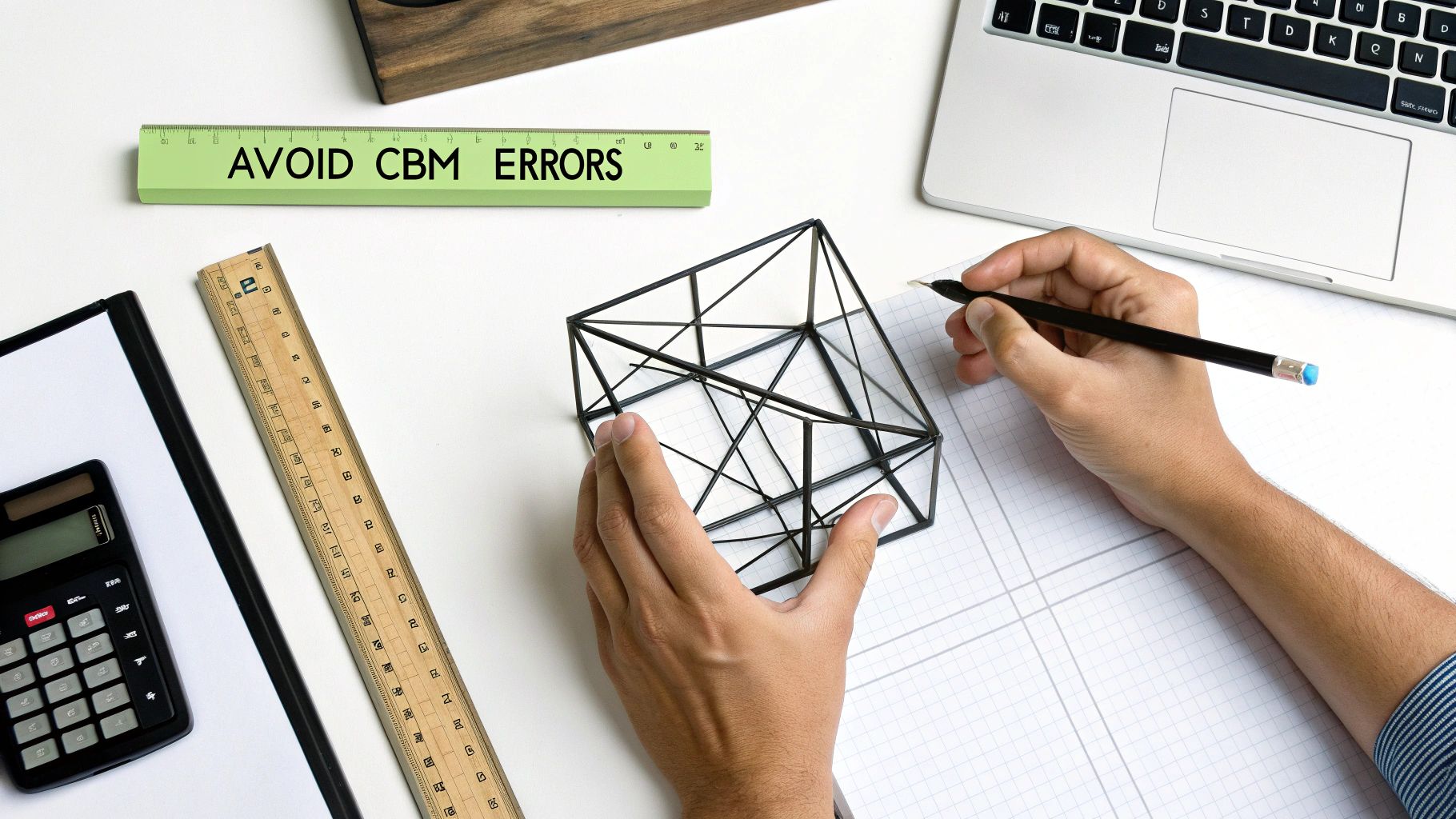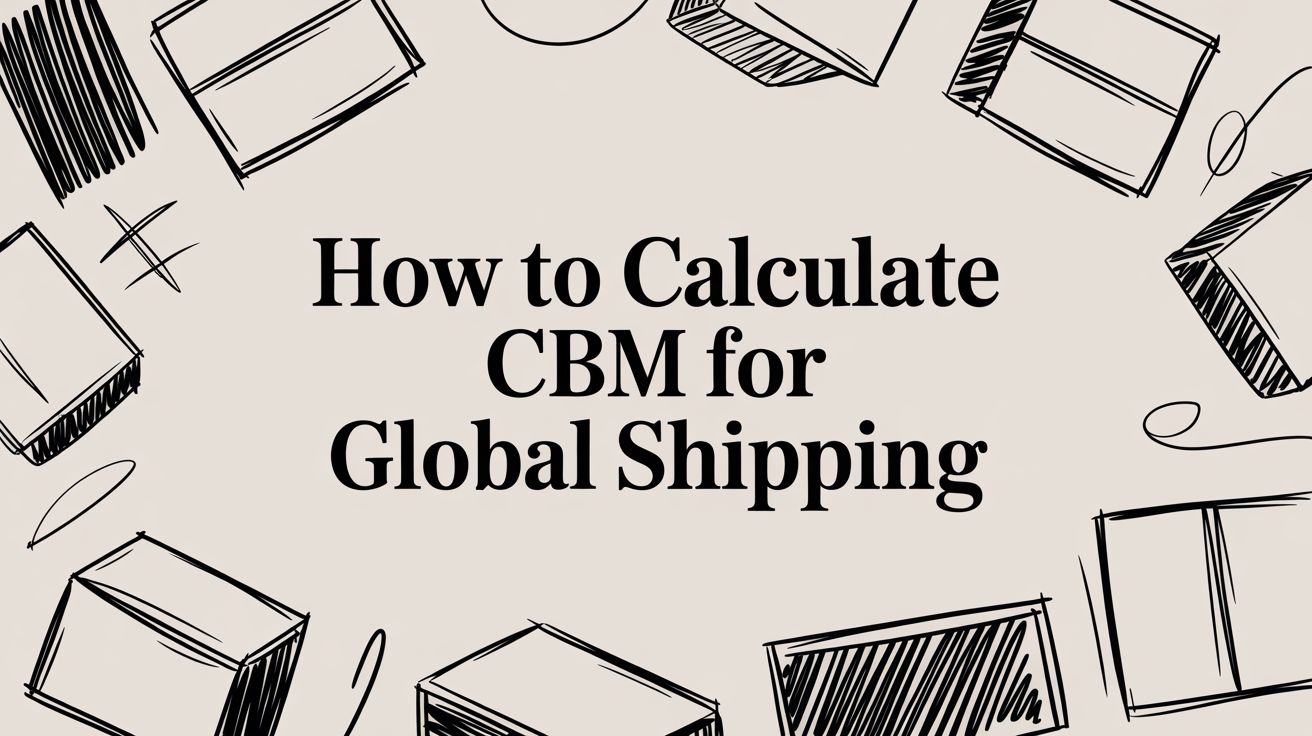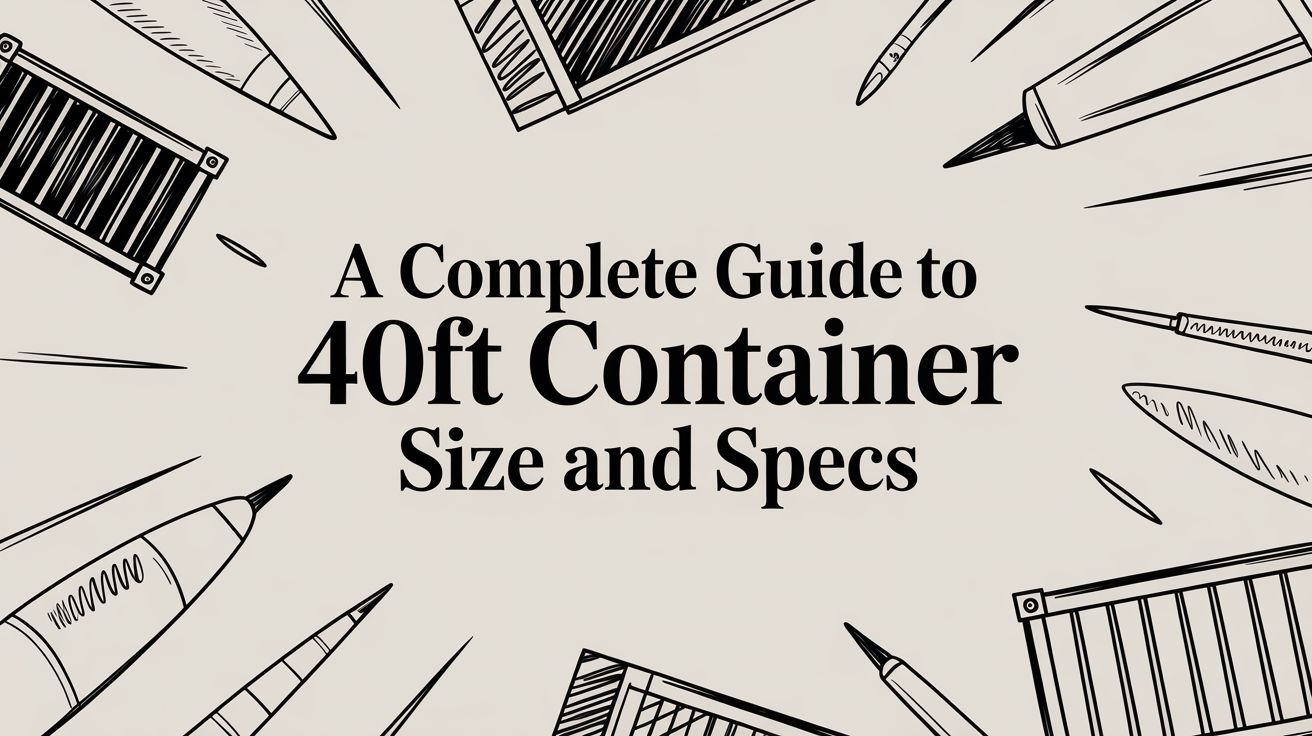To calculate your shipment's CBM, or Cubic Meter, you simply multiply its length, width, and height together. The core formula is straightforward: Length (m) x Width (m) x Height (m) = CBM. This single calculation is the bedrock for nearly all international sea and air freight costs, so getting it right is crucial.
Calculating CBM: The Essential First Step
If you're involved in global trade, understanding how to calculate CBM isn't just helpful—it's non-negotiable. Think of it as the universal language of volume in logistics. It dictates everything from your initial freight quote to how your cargo is physically loaded into a container. Without a solid handle on this metric, you're essentially flying blind, risking overpayments and surprise charges down the line.
The process kicks off with one golden rule: all measurements must be in meters. This is the most common trip-up I see with first-time shippers. Your supplier might provide dimensions in centimetres, inches, or millimetres, but you have to convert them to meters before you do anything else.
Converting Units To Meters
Getting the conversion right is the make-or-break part of the process. A small error here will compound and throw off every other calculation you make.
Here's a quick rundown:
- From Centimetres (cm): Divide by 100. A box that's 80 cm long becomes 0.8 m.
- From Inches (in): Multiply by 0.0254. A 40-inch pallet is 1.016 m.
- From Millimetres (mm): Divide by 1000. An item measuring 500 mm is 0.5 m.
For a quick reference, I've put together a table to keep these conversions handy.
CBM Calculation Quick Reference
This table summarizes the essential formulas and unit conversions you'll need for fast and accurate CBM calculations.
| Measurement Unit | Conversion to Meters | Example Formula |
|---|---|---|
| Centimetres (cm) | Divide by 100 | (L cm / 100) x (W cm / 100) x (H cm / 100) |
| Inches (in) | Multiply by 0.0254 | (L in * 0.0254) x (W in * 0.0254) x (H in * 0.0254) |
| Millimetres (mm) | Divide by 1000 | (L mm / 1000) x (W mm / 1000) x (H mm / 1000) |
Once you have all your dimensions in meters, it's just a matter of applying the formula. For a single carton, it’s a direct multiplication.
If you're shipping multiple identical cartons, first find the CBM for one, then multiply that result by the total number of cartons. This gives you the total shipment volume—the key figure you and your freight forwarder need for planning. Knowing your total CBM is also critical when deciding which container is right for your cargo. To get a better feel for container capacities, check out our guide on the 40 ft container size.
This standardisation across the industry is what keeps global trade moving efficiently. In China, for example, the volume of commodities like timber is officially tracked in cubic meters to ensure consistent national reporting and simplify international commerce. This reliance on CBM is even reflected in official economic data, as you can see in this official press release from the National Bureau of Statistics of China.
Putting The CBM Formula Into Practice
Knowing the formula is one thing, but applying it to real-world shipments is where it really counts. Let's walk through a few common scenarios you’ll definitely face when shipping goods from China, moving from the simple to the more complex.
This simple graphic breaks down the whole process into three key actions: getting your measurements, converting them into meters, and then doing the final volume calculation.

Think of this as the essential workflow. It shows that getting accurate measurements and converting your units correctly are the critical first steps before you can even think about the final CBM number.
Example 1: Calculating CBM For A Single Box
Let’s start with the basics. Imagine you’re shipping a single, standard carton. Your supplier in China gives you the dimensions: 60 cm long, 40 cm wide, and 50 cm high.
Before anything else, you have to convert these figures into meters. The rule is simple: just divide each centimetre value by 100.
- Length: 60 cm ÷ 100 = 0.6 m
- Width: 40 cm ÷ 100 = 0.4 m
- Height: 50 cm ÷ 100 = 0.5 m
Now, you can plug those numbers into the CBM formula:
0.6 m x 0.4 m x 0.5 m = 0.12 CBM
And there you have it. The volume of this single box is 0.12 cubic meters. That's the exact figure you'd give to your freight forwarder to get a shipping quote.
Example 2: Total CBM For Multiple Identical Cartons
More often than not, you'll be shipping a whole batch of the same item. Let's say you're moving 200 identical boxes, each with the same dimensions as our first example (0.6 m x 0.4 m x 0.5 m).
Since you’ve already figured out the CBM for a single box is 0.12 CBM, the rest is easy. To get the total volume for the entire consignment, you just multiply that number by how many cartons you have.
0.12 CBM (per box) x 200 boxes = 24 CBM
Your total shipment volume is 24 CBM. This is a key number because it helps determine whether your cargo will ship as Less than Container Load (LCL) or if you'll need to book a Full Container Load (FCL).
Example 3: Handling A Shipment With Mixed Box Sizes
But what happens when things get a little more complicated? Many importers deal with orders that have products packed into cartons of all different sizes. Let's break down how to handle a mixed shipment.
Imagine your order consists of:
- 50 boxes at 80 cm x 60 cm x 40 cm
- 100 boxes at 40 cm x 30 cm x 20 cm
The trick here is to calculate the total CBM for each group of boxes separately first.
Group 1 (the 50 large boxes):
- Convert to meters: 0.8 m x 0.6 m x 0.4 m = 0.192 CBM per box
- Total for this group: 0.192 CBM x 50 boxes = 9.6 CBM
Group 2 (the 100 small boxes):
- Convert to meters: 0.4 m x 0.3 m x 0.2 m = 0.024 CBM per box
- Total for this group: 0.024 CBM x 100 boxes = 2.4 CBM
Finally, just add the totals from both groups together to get your grand total.
9.6 CBM + 2.4 CBM = 12 CBM
The total volume for your entire mixed shipment is 12 CBM.
Getting the total CBM right for mixed shipments is absolutely vital. Miscalculations are a common source of unexpected charges, since freight forwarders base their quotes on the total volume you provide. Always double-check your maths for each group before adding them up.
By working through these examples, you can see how the CBM calculation works for pretty much any type of shipment you'll encounter. Mastering this helps you get much more precise quotes and ultimately make smarter logistics decisions. If you're curious to see how CBM directly impacts your shipping costs, play around with our online sea freight cost calculator for a quick estimate.
Why Your CBM Calculation Matters
Getting your shipment's CBM right is about more than just numbers on a page; it's the bedrock of your entire freight cost. Think of an accurate calculation as your first line of defence against surprise fees and blown budgets. When you understand your CBM, you understand the logic behind logistics pricing, which puts you in a much stronger position to make smart shipping choices.
The freight world runs on a simple principle: carriers need to be paid for both the weight and the space your cargo takes up. This is where we get into the difference between gross weight (what a scale says) and volumetric weight (the amount of room it occupies).
The Chargeable Weight Dilemma
Let’s get practical. Imagine you're shipping two very different products. One is a small, compact box of heavy steel components. The other is a massive, but very light, box of foam cushions.

Even though the cushions weigh next to nothing, they gobble up a huge amount of valuable space inside a container. The steel parts are the opposite—heavy, but they don't take up much room.
To solve this, carriers calculate what's called chargeable weight. They'll figure out both the gross (actual) weight and the volumetric weight of your shipment. Then, they bill you based on whichever number is higher. This is exactly why a big, light shipment can end up costing you more than something small and heavy. Your CBM is the key that unlocks the volumetric weight calculation.
Key Takeaway: Freight forwarders don't just care about how heavy your goods are. They care equally about how much room they take up. The higher of the two—actual weight or volumetric weight derived from CBM—becomes your chargeable weight.
LCL vs FCL When Does CBM Dictate Your Choice?
Your total CBM is also the tipping point for one of the biggest decisions you'll make: shipping via Less than Container Load (LCL) or Full Container Load (FCL). This choice has a huge knock-on effect on your final cost, how long it takes to arrive, and how your goods are handled.
For smaller shipments, you're essentially buying a portion of a container's space (LCL). For larger ones, you book the whole thing for yourself (FCL). The total CBM is what tells you where the financial break-even point is.
Here’s a quick breakdown of how CBM helps you decide:
| Factor | Less than Container Load (LCL) | Full Container Load (FCL) |
|---|---|---|
| Ideal For | Small shipments, typically under 15 CBM. | Larger shipments, typically over 15 CBM. |
| Cost Structure | Pay per cubic metre; cost-effective for smaller volumes. | Pay a flat rate for the entire container, regardless of fill. |
| Transit Time | Generally longer due to consolidation and deconsolidation at ports. | Faster and more direct, as the container is sealed for you only. |
| Handling | More handling involved, slightly increasing risk of damage. | Minimal handling, as your goods remain untouched until arrival. |
So, if your total volume works out to be 12 CBM, LCL is almost always going to be the way to go. But if your shipment is 18 CBM, you'll often find it's actually cheaper to book an entire 20ft container (FCL) than it is to pay the per-CBM rate for such a large LCL shipment.
To accurately estimate your moving expenses, you'll need to understand how volume impacts pricing. A comprehensive resource on how to use a long distance moving cost calculator guide can provide valuable insights into this process. Getting the CBM calculation right from the start means you can confidently compare these options, avoiding the classic mistakes of paying for empty space in an FCL container or overpaying on high LCL rates.
Avoiding Common CBM Calculation Mistakes
Even with a simple formula like Length x Width x Height, it’s surprisingly easy to make costly errors when you’re calculating CBM. I’ve seen small miscalculations snowball, leading to unexpected freight charges and frustrating back-and-forths with carriers. Learning to spot and sidestep these common pitfalls is a crucial skill for any importer.
The single biggest mistake we see, time and time again, is mixing measurement units. A supplier might give you dimensions in inches, you start thinking in centimetres, and then forget to convert the final number to cubic meters.
It sounds basic, but it happens constantly. The golden rule is this: always convert every single measurement—length, width, and height—into meters before you multiply anything. This simple discipline prevents the most frequent and expensive errors right from the start.

Rounding and Inaccurate Measurements
Another common trap is improper rounding. It might seem harmless to round 1.254 meters down to 1.25 meters, but across a shipment of 200 cartons, that tiny inaccuracy adds up fast.
As a best practice, always round your measurements up to the next two decimal places. Think of it as rounding up to the nearest centimetre.
Here’s how that works in practice:
- If a measurement is 1.254 m, use 1.26 m.
- If a measurement is 0.788 m, use 0.79 m.
This approach provides a slight buffer and ensures you won't be under-quoted by your freight forwarder. It protects you from getting hit with a surprise balance invoice down the line.
Measuring Irregularly Shaped Items
Of course, not everything ships in a perfect rectangular box. When you have oddly shaped or cylindrical items, the key is to measure the maximum dimensions. Imagine enclosing the item in a theoretical "box" that touches its absolute longest, widest, and highest points.
Always use these extreme points for your length, width, and height calculations. Carriers bill for the total space an item occupies on the truck or in the container, not its precise geometric volume. Ignoring a handle that sticks out or a bulge in the packaging can lead to a costly remeasurement fee from the carrier.
Trust, But Verify Supplier Dimensions
Finally, one of the most important pieces of advice I can give is to never blindly trust the dimensions provided by your supplier. While most suppliers are honest and accurate, mistakes happen. Discrepancies between their numbers and the carrier's final measurements are a frequent source of billing conflicts.
Whenever possible, ask your supplier for photos showing the cartons being measured, with a tape measure clearly visible. If you're using a third-party inspection service (which is always a good idea), make dimensional checks a mandatory part of their report. A quick verification upfront can save you hundreds, or even thousands, of pounds on a large shipment. Taking this extra step ensures the CBM you calculate is the one you'll actually be billed for.
Using CBM to Your Advantage When Shipping from China
Knowing your CBM is more than just a bit of math; it's your key to smarter, cheaper importing from China. When you get a handle on this simple metric, you’re no longer just a buyer—you become a savvy manager of your own supply chain. It's not about the number itself, but what you can do with it to unlock real savings.
The whole process should kick off long before your products are even packed. You need to be proactive with your Chinese supplier. Don't just sit back and wait for the final packing list. As soon as your production run is confirmed, ask for the estimated carton dimensions and weight.
Getting this data early means you can get solid, reliable freight quotes from forwarders like us at Upfreights well ahead of time. This simple step helps you avoid nasty last-minute budget surprises and gives you a crystal-clear picture of your total landed cost, which is absolutely vital for pricing your products profitably.
Turn Your CBM into a Negotiating Tool
When you walk up to a freight forwarder with a precise total CBM and gross weight, you immediately signal that you know what you're doing. This clarity takes all the guesswork out of their quoting process, allowing them to give you their best rates right off the bat. A solid grasp of your CBM becomes one of your strongest negotiating tools.
For example, if you know your total shipment is 14 CBM, you can confidently push for the best LCL (Less than Container Load) rates. But what if it’s 16 CBM? Now you can start a different conversation—asking if it makes more financial sense to just book your own 20ft container (FCL). You can't make these strategic plays without an accurate CBM figure from the very beginning.
Insider Tip: Always ask your supplier for the "carton packing list." This document should detail the dimensions, weight per carton, and total number of cartons. It’s the single source of truth you need to calculate your CBM and get firm, no-surprise shipping quotes.
How Smart Packaging Can Slash Your Freight Costs
Beyond just calculating the volume, you can actively work with your supplier to shrink it. Packaging optimization is one of the most overlooked yet powerful ways to cut down on shipping expenses. Tiny adjustments can add up to huge savings, especially when you're moving hundreds or thousands of units.
Here are a few things to discuss with your supplier:
- Shrink the Carton: Is there any way to pack the product more tightly? Even shaving off a single centimetre from each dimension can massively reduce the total CBM when multiplied across an entire shipment.
- Perfect the Pallet Stack: If you're shipping on pallets, make sure the cartons are stacked like a perfect puzzle. You want to eliminate any overhang and wasted space. A tightly packed pallet is a smaller, cheaper pallet.
- Think About Disassembly: For bulkier items, could they be shipped partially disassembled? It might seem like a hassle, but it can often slash the CBM and your final freight bill.
For anyone managing the logistics of getting products from A to B, digging into best practices for shipping from China to Amazon FBA can offer some fantastic insights. The principles apply to almost any shipment. Remember, small changes you make to your packaging in China can have a massive ripple effect, leading to lower costs for freight by sea and a much healthier profit margin for your business.
Digging a Little Deeper: Common CBM Questions
Once you get the hang of the basic CBM formula, the real-world questions start popping up. We get these all the time from clients, so let's tackle the most common ones.
A big one is whether you can just use a free online CBM calculator and call it a day. Sure, those tools are handy for a quick estimate, but relying on them completely can be a costly mistake.
An online calculator is just a machine following a script; it can't think for you. It's only as accurate as the numbers you punch in. If you don't know how to measure properly, handle unit conversions, or account for mixed-size cartons, you're setting yourself up for a classic "garbage in, garbage out" scenario. Understanding the process yourself means you can feed the calculator good data, and more importantly, you'll be able to sanity-check the quotes you get back from suppliers or freight forwarders. That's a skill no online tool can replace.
So, How Many Boxes Can I Actually Fit in a Container?
This is the million-dollar question, and the honest answer is always, "it depends." While every container has a maximum CBM listed on the door, you will never, ever use 100% of that space. It's just not possible. You lose volume to small gaps between cartons, the space taken up by pallets, and the simple reality of stacking real-world boxes.
For planning purposes, here are some realistic loading capacities you can work with:
- 20ft Container: Max volume is 33 CBM, but a good, efficient load will be closer to 25–28 CBM.
- 40ft Container: Has a total space of 67 CBM, but you should plan on loading between 55–58 CBM.
- 40ft High Cube (HQ) Container: Gives you about 76 CBM to play with, meaning a practical capacity of 65–68 CBM.
Think of these numbers as a reliable rule of thumb. Your final tally will come down to how well your cargo fits together. A shipment of identical, sturdy boxes will always pack more tightly than a mixed load of various shapes and sizes.
Does CBM Matter for Air Freight?
This is where a lot of importers get tripped up. While CBM is the king for LCL sea freight pricing, air freight operates on a slightly different principle: volumetric weight, sometimes called dimensional weight.
The logic is the same—airlines need to charge for the space an item takes up, not just its physical weight. A massive box of pillows weighs very little but fills a lot of valuable cargo space. To account for this, they calculate a "volumetric weight" and compare it to the actual gross weight, then charge you for whichever figure is higher.
The standard formula for volumetric weight looks like this:
Length (cm) x Width (cm) x Height (cm) / 6000 = Volumetric Weight (in kg)
Be aware that the divisor isn't set in stone; some carriers use 5000, which can change the final number. The critical takeaway here is the unit. The air freight calculation gives you a weight in kilograms, whereas CBM is a pure volume measurement (m³). Understanding this difference is essential when you're comparing quotes for shipping by air versus by sea.



